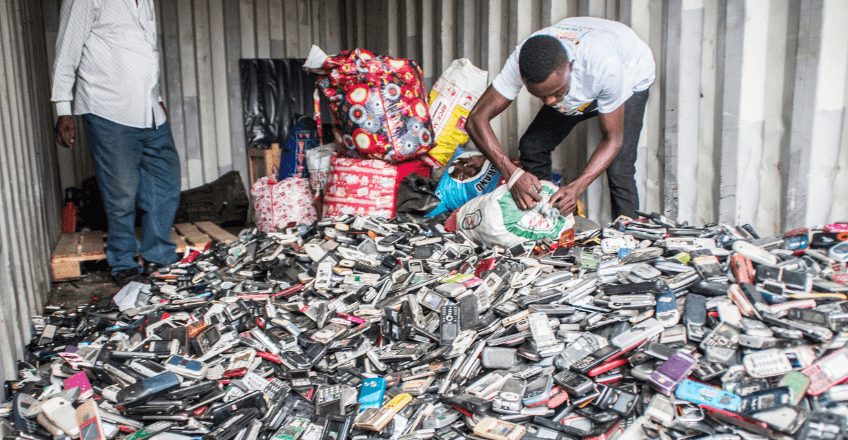The Impact of Disposing and Recycling Mobile Phones
Published date: June 2024

Smartphones have become a necessity in our seamlessly connected and modern world. But what happens to these devices when they reach the end of their lifespan or are thrown away? Improper disposal of smartphones poses a significant threat to the environment while recycling offers a complex solution with its own limitations. Let's delve deeper into the long-term environmental impacts of both scenarios.
Why E-Waste is an Environmental Disaster
- Toxic Leaching: Smartphones contain a cocktail of hazardous materials like lead, arsenic, and mercury. Landfills are not designed to contain these elements, which can leach out over time and contaminate soil and groundwater. This contamination can enter the food chain, posing health risks to humans and wildlife.
- Microplastic Pollution: Even the plastic casings of smartphones contribute to the growing problem of microplastics. These tiny plastic fragments break down from larger pieces and end up in our oceans, harming marine life and potentially making their way back to us through the seafood we consume.
- Resource Depletion: Smartphones are packed with valuable rare earth elements like lithium and cobalt. Mining these materials often involves significant carbon emissions and environmentally destructive practices like deforestation and water pollution. Improper disposal squanders the opportunity to recover these resources for future use.
The Challenges and Benefits of Recycling Mobile Phones
- Limited Efficiency: Current recycling technologies struggle to efficiently separate the components of a smartphone. This means a large portion of the phone may still end up in landfills, along with the toxic materials it contains.
- Energy Consumption: Recycling mobile phones requires a lot of energy, contributing to greenhouse gas emissions. However, studies show that the environmental impact of recycling is still far less than that of producing an entirely new smartphone.
- Informal Recycling Practices: In developing countries, a large portion of e-waste is handled through informal recycling sectors. These operations often lack proper safety measures and environmental controls, leading to further pollution and worker health problems.
Solutions to Reduce E-Waste
- Extending Phone Lifespan: The most significant environmental impact comes from the manufacturing process. Encouraging consumers to hold onto their phones for longer by offering repairability and long-term software updates can reduce the environmental footprint. Manufacturers should also offer trade-in programs or refurbishment initiatives to give old phones a second life. However, all mobile manufacturers need to take more responsibility for what they produce and extend the lifespan of their devices.
- Limiting Damage through Design: Manufacturers can design smartphones with easier disassembly and more material recovery in mind. This would make future recycling processes more efficient and allow for a larger percentage of valuable resources to be recouped. For instance, using modular components or incorporating highly recyclable materials could be explored.
- Improved Recycling Infrastructure: Investment in research and development of new recycling technologies is crucial to improve efficiency and minimise environmental impact. Additionally, establishing stricter regulations on e-waste handling can ensure responsible practices throughout the recycling chain. This could involve producer responsibility schemes, where manufacturers are held accountable for the end-of-life management of their products.
- Consumer Awareness: Educating consumers about the environmental impact of smartphones and responsible disposal practices is vital. Clear labelling and take-back programs offered by manufacturers can make recycling more accessible and encourage participation.
Fairphone 4 and 5, the Sustainable Smartphones
Fairphone, a social enterprise dedicated to ethical smartphone production, offers a unique solution to the regular cycle of disposal and e-waste. The Fairphone 4 and 5 are designed with a focus on repairability and longevity, with high performance to match:
- Modular Design: Both Fairphone 4 and 5 feature a modular construction that allows users to easily replace individual components like batteries, cameras, or screens, instead of replacing the entire phone when one-part malfunctions. This reduces the need for frequent upgrades and costly, carbon-intensive repairs. A modular design significantly extends the lifespan of the device.
- Durable, Recycled Materials: Fairphone prioritises the use of recycled and responsibly sourced materials in their phones, along with Fairtrade Gold. This minimises the environmental impact associated with raw material extraction and provides a strong set of materials to cope with daily wear and tear.
- Extended Warranty and Software Support: Fairphone offers a 5-year extended warranty and guarantees software updates until at least 2031 for the Fairphone 5. This encourages users to hold onto their phones for longer, further reducing e-waste generation.
- Take-Back Programs: Fairphone offers take-back programs for their phones, ensuring responsible recycling practices at the end of their lifespan.
Fairphone represents a significant step towards more sustainable smartphone consumption, proving that it's possible and desirable, today.
Explore the world's most sustainable mobile, the Fairphone here.
Read how you can further help the environment by reducing your carbon footprint in time for 2023.




Leave us your comment
You need to login to submit a comment. Please click here to log in or register.